Introduction
Understanding the complexities of body fat composition is crucial for fostering a healthier workforce. As organizations strive to enhance employee well-being, recognizing the significant differences between visceral fat, often dubbed "hard fat," and subcutaneous fat, or "soft fat," becomes essential. The implications of these fat types extend beyond aesthetics; they are intimately linked to serious health risks such as heart disease and diabetes.
By delving into the physiological roles and health consequences associated with each type of fat, HR Benefits Managers can advocate for informed health initiatives that promote awareness and proactive measures. This article unpacks the critical distinctions between hard and soft fat, explores their health implications, and offers actionable strategies for managing body fat effectively, empowering organizations to prioritize their teams' health and vitality.
Defining Hard Fat and Soft Fat: Key Differences
Visceral fat, often categorized under hard vs soft fat, resides deep within the abdominal cavity, enveloping critical organs such as the liver and pancreas. This type of fat is not only firmer but also poses significant health risks, including increased susceptibility to heart disease and diabetes. A systematic review and meta-analysis of 230 cohort studies, which included 3.74 million deaths among 30.3 million participants, underscores the dangers associated with abdominal fat.
In contrast, subcutaneous fat, or soft fat, is located just beneath the skin and is typically found in areas like the thighs and arms, illustrating the differences in distribution when considering hard vs soft fat. This fat is more pliable and, while not without its own risks, is generally regarded as less harmful than internal fat. Understanding the vital differences between hard vs soft fat is essential, as they carry distinct implications based on their anatomical locations and physiological functions.
Recent studies reveal a stark reality: visceral fat is associated with a higher incidence of complications, emphasizing the necessity for accurate assessment techniques. As Chika Anekwe, MD, MPH, points out, fat found at the hips and thighs is protective, which emphasizes the significance of differentiating between fat types in management. This knowledge empowers HR Benefits Managers to advocate for wellness initiatives that address body fat composition, promoting a healthier workforce.
The ongoing advancement of measurement technologies, like MRI and CT scans, although expensive, signifies a chance to improve our comprehension of these fat types and their implications for management strategies. Furthermore, advanced imaging technologies like Dual Energy X-ray Absorptiometry and Air Displacement Plethysmography illustrate the limitations of current measurement techniques, as they cannot accurately distinguish between different types of adipose tissue, necessitating further advancements in imaging methods.
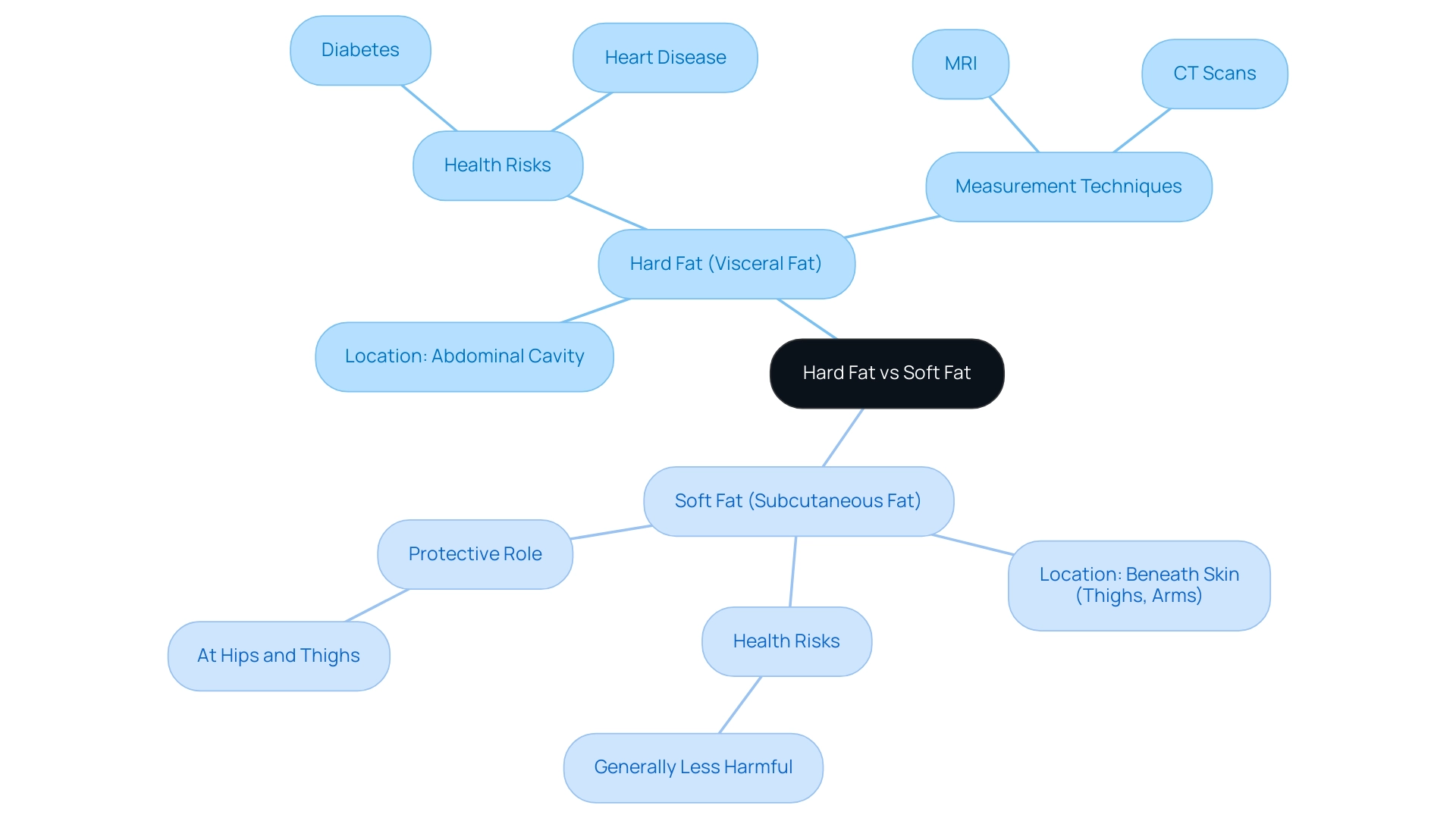
Health Implications of Hard vs Soft Fat: What You Need to Know
Research consistently emphasizes the risks associated with excess hard vs soft fat, linking hard fat specifically to obesity-related illnesses such as type 2 diabetes, cardiovascular disease, and metabolic syndrome. Notably, Pasarica et al. found that reduced oxygenation in obese adipose tissue is associated with impaired insulin suppression of lipolysis, further illustrating the physiological effects of hard fat.
In contrast, when discussing hard vs soft fat, it is evident that while soft fat can accumulate and contribute to weight gain, it is typically less harmful and may even serve beneficial roles, providing insulation and energy reserves. As Kiran K. Panuganti succinctly states,
Obesity is the result of an imbalance between daily energy intake and energy expenditure, resulting in excessive weight gain.
This emphasizes the significance of comprehending physical composition, especially the risks presented by abdominal fat.
Furthermore, recent studies indicate that leptin has a complex role in cardiovascular disease, suggesting both pro-atherogenic effects and potential cardioprotective actions post-myocardial infarction. The implications of abdominal fat extend beyond individual health; with nearly 1 in 3 children in the U.S. affected by obesity, and significant disparities among racial/ethnic groups, it is crucial to recognize the broader societal context. Maintaining a healthy balance by focusing on reducing hard vs soft fat through diet and exercise is essential.
Real-world examples demonstrate that lifestyle changes can lead to substantial improvements in physical composition, effectively reducing visceral fat. As HR Benefits Managers, it’s imperative to advocate for awareness and proactive measures regarding body fat composition to foster a healthier workplace.
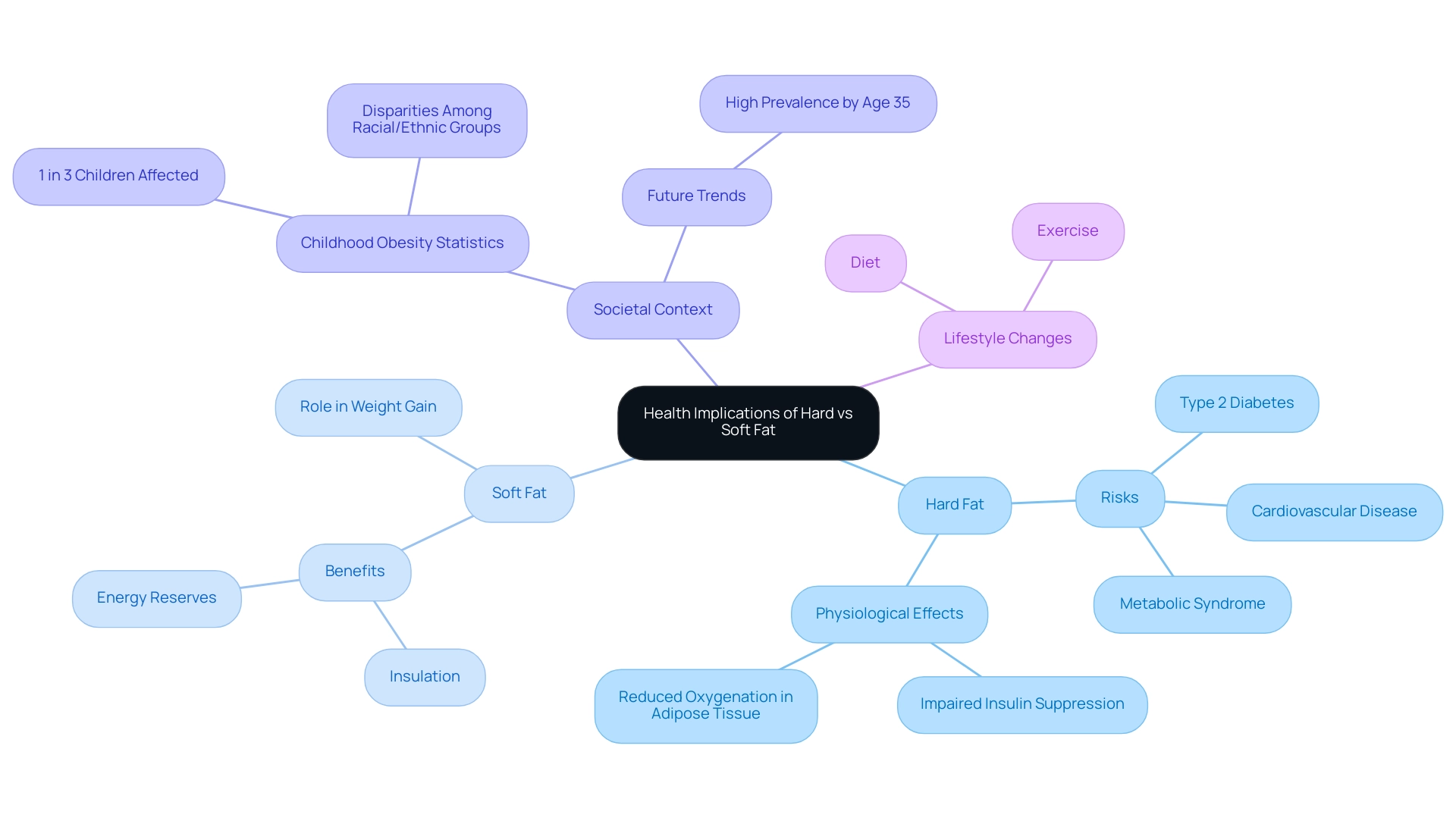
Where is Hard and Soft Fat Found? Locations and Appearances
Hard fat, mainly located in the abdomen and situated deep within the abdominal cavity, presents unique challenges due to its invisibility. This abdominal fat can often be assessed through advanced imaging techniques or simple waist circumference measurements, where maintaining a healthy waist-height ratio of no greater than 0.5 is crucial. Significantly, the majority of fatty acids in systemic circulation come from the breakdown of subcutaneous fat instead of abdominal fat, emphasizing the importance of comprehending fat distribution in wellness evaluations.
On the other hand, soft fat is more apparent, residing just beneath the skin and commonly accumulating in the hips, thighs, and arms. Comprehending the locations of hard vs soft fat types is crucial in assessing risks to well-being. As Jacob C. Seidell emphasizes, understanding the visibility differences between hard vs soft fat can be a game changer in health assessments.
Furthermore, omental adipocytes possess greater lipolytic potential than subcutaneous fat cells, underscoring the importance of abdominal fat. To combat the risks associated with abdominal fat, lifestyle changes such as regular exercise and a healthy diet are recommended. Engaging in at least 30 minutes of moderate aerobic exercise daily and consuming a diet rich in calcium and vitamin D, while low in trans fats, can effectively reduce both visceral and subcutaneous fat.
Therefore, it’s essential for individuals to learn how to identify soft fat accumulation and to engage in meaningful discussions with healthcare professionals about their composition. Taking proactive steps in this area not only contributes to personal wellness but also fosters a culture of well-being within the workplace.
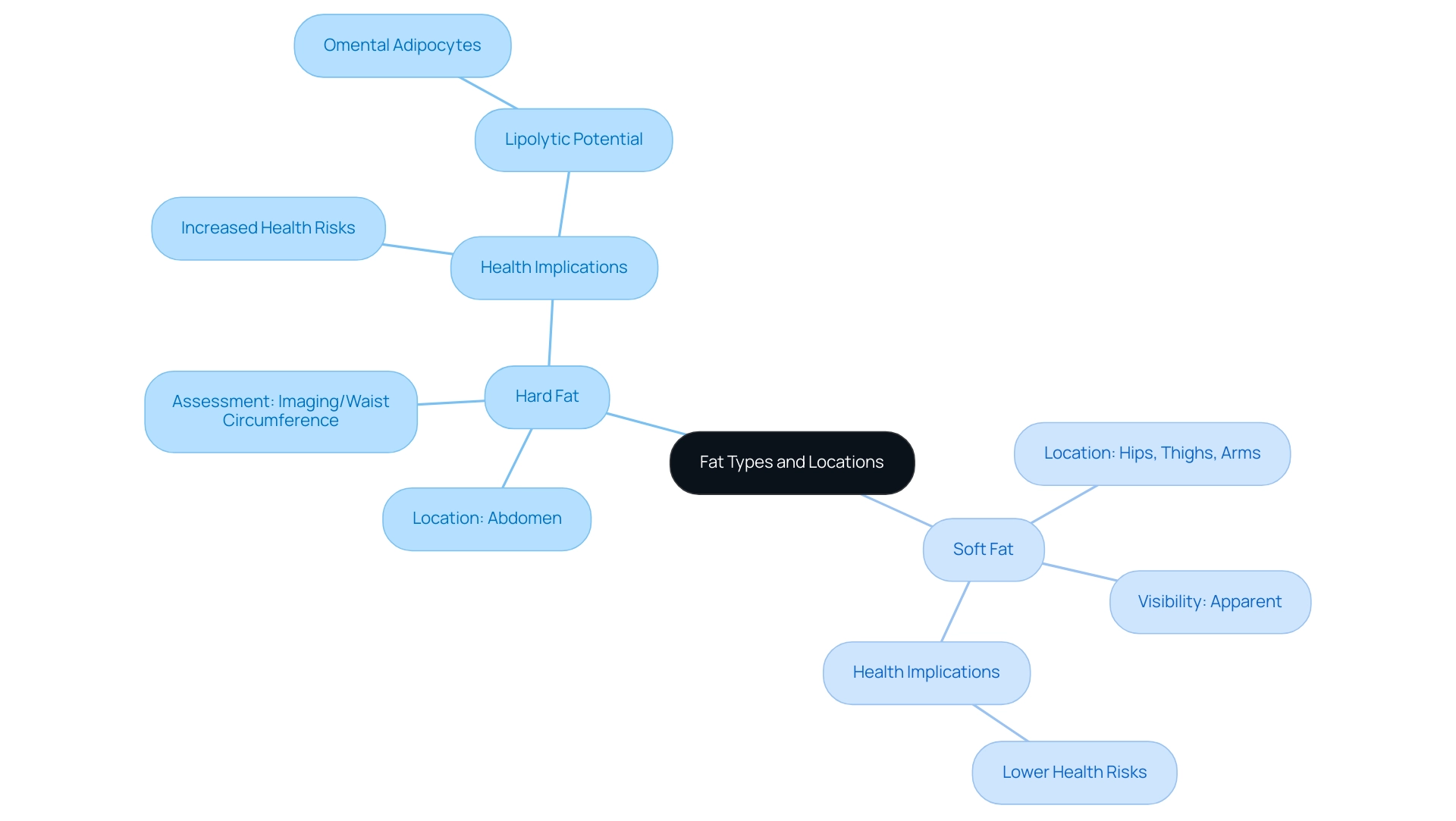
The Role of Hard and Soft Fat in Body Functionality
The function of fat composition in wellness is multifaceted, particularly when considering the significant effect of hard vs soft fat on hormone regulation. Excess hard fat is associated with increased production of inflammatory markers, which can lead to insulin resistance, a condition that poses serious metabolic risks. In contrast, when discussing hard vs soft fat, soft fat serves essential functions, including:
- Energy storage
- Insulation
- Organ protection
It is also crucial in the production of leptin, a hormone that plays a vital role in appetite regulation. Recent research emphasizes that the hormonal effects of visceral fat on metabolism are crucial; for example, studies have indicated that 14 out of 52 examined polymorphisms may play a role in adiposity among Russian women, highlighting the significance of personalized wellness strategies. Additionally, data from the INTERCATH study indicates a significant correlation between adherence to the Med-Diet and levels of high sensitivity C-reactive protein (HS-CRP), emphasizing the relationship between diet and inflammatory markers.
Moreover, the investigation of how the COVID-19 pandemic can uncover underlying mental well-being issues illustrates the wider context of implications related to fat composition. By understanding these intricate roles, HR Benefits Managers can advocate for health initiatives that recognize the nuanced relationship between body fat composition and overall well-being.
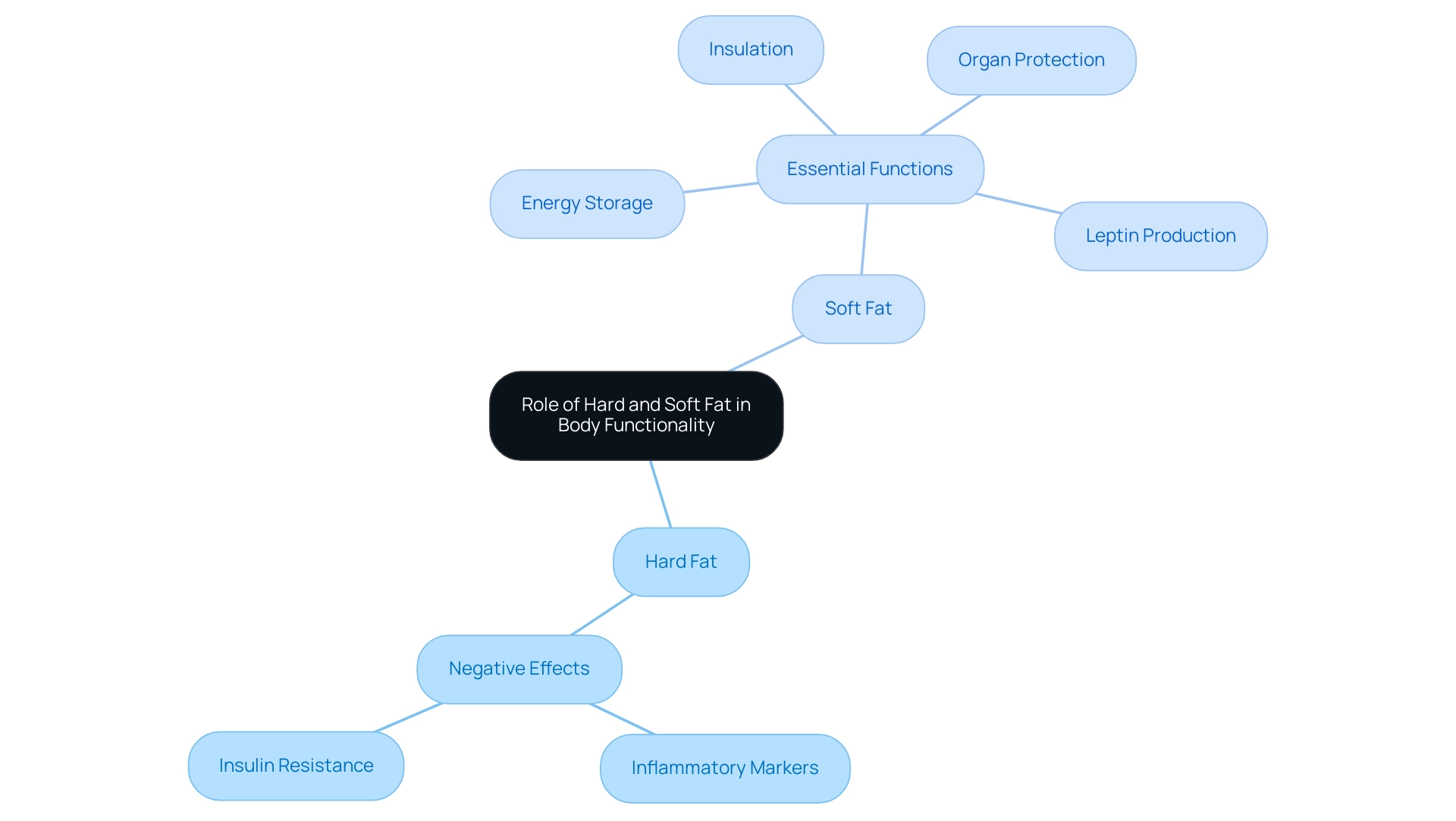
Maintaining a Healthy Balance: Tips for Managing Hard and Soft Fat
To effectively manage hard vs soft fat, it is essential to incorporate regular physical activity into your routine, focusing on both aerobic exercise and strength training. Research shows that exercise interventions can significantly reduce visceral fat, particularly in specific demographic groups. A review assessed the effectiveness of exercise interventions across different age groups, finding a standardized mean difference (SMD) of -0.54 in adolescents (12-18 years) and -0.42 in young adults (18-24 years).
This data underscores the importance of targeting older youth for these interventions. Furthermore, as noted in the Sasai H et al. research regarding hard vs soft fat, the 2010 study shows that physical activity is crucial for reducing hard vs soft fat in the abdominal region.
Additionally, a modest increase in weekly caloric expenditure can lead to substantial decreases in abdominal fat without the need for drastic caloric intake changes. Alongside exercise, adopting a balanced diet rich in whole foods, lean proteins, healthy fats, and fiber is vital. By limiting processed foods and added sugars, you can further enhance body composition.
Ensuring sufficient sleep and employing stress management techniques—such as mindfulness or yoga—can support your efforts in achieving a healthy fat balance. As fitness expert Rong Wang points out, the impact of exercise interventions on visceral fat reduction is particularly pronounced in males, making tailored strategies even more critical. Embracing these holistic approaches can foster not only personal well-being but also create a culture of health within your team.
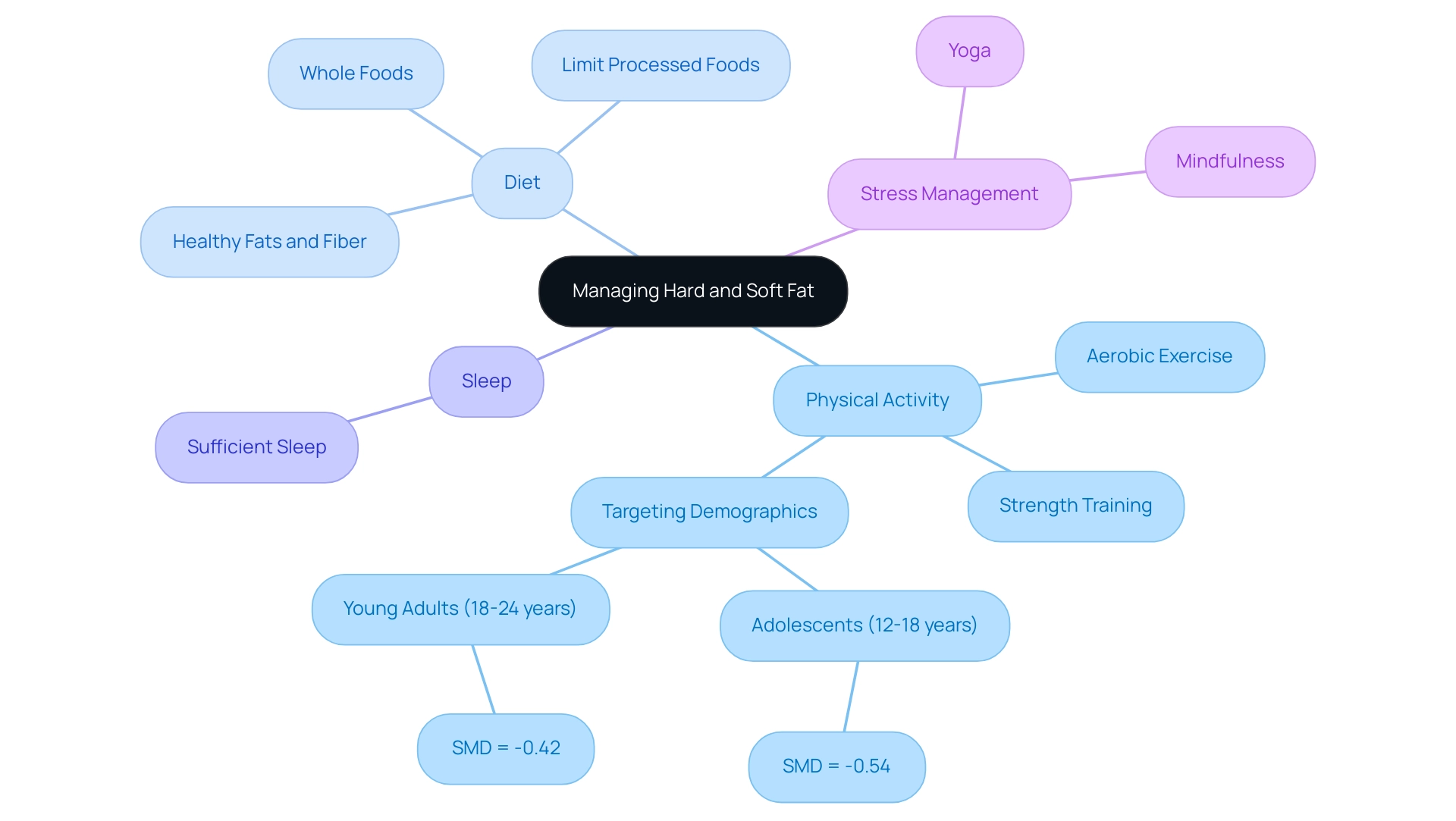
Conclusion
Understanding the distinctions between hard and soft fat is pivotal for fostering a healthier workforce. The significant health risks associated with visceral fat, including heart disease and diabetes, highlight the urgency for proactive health management strategies. By recognizing the anatomical differences and physiological roles of these fat types, HR Benefits Managers can advocate for informed initiatives that prioritize employee well-being.
Implementing targeted health initiatives that address body fat composition is essential. Encouraging regular physical activity, promoting balanced diets, and fostering a supportive workplace culture can lead to substantial improvements in health outcomes. The evidence shows that lifestyle changes can effectively reduce visceral fat, positively impacting overall health and productivity.
In conclusion, prioritizing awareness and education around body fat composition not only empowers individuals to take charge of their health but also cultivates a thriving organizational environment. By embracing these strategies, organizations can ensure that their teams remain healthy, engaged, and ready to face the challenges of today's workplace. Now is the time to take action and invest in the well-being of every employee.




